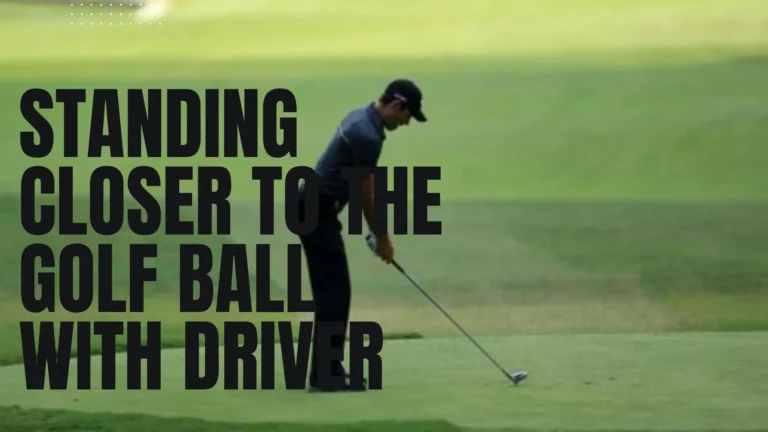Proper Stance: Improving Your Drive With a Firm Foundation
A good stance is a must for any golfer who wants to improve their drive power and accuracy. Your stance is the foundation for repeatable, high-quality swings and helps to stabilize your body as you rotate through the ball.
Understanding key elements such as width, balance, posture, and alignment is required to master an optimal driver stance. Perfection takes practice, but learning the fundamentals fosters body awareness, which is essential for progress.
Getting the Right Stance Width
Balance and swing leverages are affected by stance width. Driver shots rely on rotary power transmitted from the ground up, so proper footing is essential. Stand shoulder-width apart, with the midlines of your feet perpendicular to your target.
Wider stances over-stabilize, which reduces coil and limits hip turn. Narrower stances make it difficult to transfer weight efficiently during crossovers. Shoulder-width foot placement keeps the upper and lower bodies working in unison.
Take practice swings with your feet paused at the top to check your foot positioning. The proper width allows for a full shoulder turn without swaying. Adjust from here based on swing feedback.
Some golfers widen their forward foot to reduce sway, while others narrow their back foot to limit reverse weight shift. Personalize, but start with shoulder-width for solid fundamentals.
Keeping Your Balance in Stance
Even footing distribution improves balance by focusing weight on the midfoot rather than the toes or heels. Balance allows your body to coil and unload power. Driver shots rely heavily on rotary sequencing, so balance is essential.
Forward weight tips limit backswings and thus range of motion. Excessive heel pressure makes it difficult to properly activate powerful glutes and core muscles. Either imbalance limits the speed capabilities of slow connections.
Wiggling toes without straining is a good way to practice midfoot balance. Engage core muscles to avoid excessively conforming arches.
Check your balance after each shot to see if your weight is creeping forward or backward. Consistent midfoot grounding improves stability and rotational capacity.
Optimizing Posture Within Stance
Posture helps to align the body’s powerful kinetic sequence, which is best suited for long drives. Ideal posture is achieved by approaching the ball with slight knee and hip flexion while maintaining a straight back.
This athletic stance reduces tension while allowing all moving parts to move freely and generate speed.
Approaching fully erect limits hip turn and isolates arms, both of which reduce clubhead velocity. Excessive flexion causes overcrouching, preventing rotation with cramped joints. Find a balanced posture in which your arms are relaxed but your back is straight.
Monitor excessive curvature at address by using mirror feedback or recording swings. Strong core engagement allows for back extension without rigidity.
Smooth rotations should be performed with slightly flexed joints from shoulder to knee. Adjust the angles until the movements feel natural. Proper posture creates the athletic platform required for velocity.
Correctly Orienting Stance Through Alignment
Misaligned stances cost accuracy and distance even with strong fundamentals. Aim feet, knees, hips, and shoulders parallel to the left of the target. Squaring each joint optimizes swing motion through impact.
Position your feet equidistant from the target line, making sure your midlines point correctly. Nudge the knees, hips, and shoulders until they are aligned. Scan all angles’ adjacency as a continuous plane. Consistent orientation creates a powerful delivery path from the inside out.
Alignment sticks, club shafts, or doorway shadows can all be used. As needed, double-check positioning angles. Through the swing’s arc, fine-tune stance symmetry and direction. Repeat the feedback adjustment drills with different foot placements. The ability to master alignment technique ensures proper ball-striking regardless of lie.
Purposefully executing placement and foot pressure
Strategic foot placement and weight transfer add advanced dimensions to properly leverage stance power. To shape the launch trajectory, adjust the front and back feet against the target line. Depending on the shot shape, pressing the inner or outer foot influences the swing path.
By delaying release for inside to out impact, angling the front foot outward promotes draws. Keep your weight centered while simply flaring out your lead foot. This shape is exaggerated by opening the back foot inward for maximum curve.
Foot pressure provides an additional layer of control. Pressing the outer back instep promotes right-to-left crosses by emphasizing lateral shift through contact. By pushing the inner heel weights in the opposite direction, you can achieve gentle fades with squared hips.
To get feedback on where and when weight moves, use impact spray or foot sensors. Purposefully refine pressure to master curving drives on command.
Training for Specific Mobility and Flexibility
A proper stance’s physically restricting elements limit core speed and power capacities. Because of limited mobility, compensation movement increases variability. Assess rotational ability, hip mobility, balance challenges, and holding postures with humility.
Train problem areas with targeted programming that strengthens both unstable and rigid links at the same time. Medicine ball throws and other rotational exercises improve three-dimensional core movement smoothing sequencing.
Dynamic lunges with rotation increase hip mobility and functionality. One-leg and plyometric drills improve balance and posture endurance.
The more mobile and resilient your body becomes, the faster proper stance fundamentals become ingrained. Persisting through painful correction stretches allows you to progress much further. Patience and acceptance of physical limitations allow for gradual and healthy stance training.
Conclusion
The proper driver stance creates a balanced platform that allows for efficient speed while maintaining directional accuracy. Mastering the fundamentals of width, balance, posture, and alignment increases physical awareness, which leads to better ball striking. Foot adjustments improve shot-shaping abilities. Maintaining optimal mobility and removing restrictions establishes a strong foundation. Revisiting proper stance fundamentals over time improves kinetic golfing proficiency. The fundamentals outlined here, when combined with persistence, will improve drive consistency.







